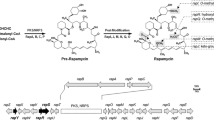Abstract
In a chemically defined medium containing aspartate, arginine and histidine to support good growth, addition of L-lysine stimulated rapamyycin production by 150%. This was probably due to its conversion to pipecolic acid, a rapamycin precursor. Phenylalanine and methionine interfered in rapamycin production by unknown mechanisms.
Similar content being viewed by others
References
Brana AF, Demain AL (1988) Nitrogen control of antibiotic biosynthesis in actinomycetes. In: Sanchez-Esquivel S (ed) Nitrogen source control of microbiol processes. CRC Press, Boca Raton, Fla, pp 99–119
Cheng YR, Hauck L, Demain AL (1995) Phosphate, ammonium, magnesium and iron nutrition of Streptomyces hygroscopicus with respect to rapamycin biosynthesis. J Ind Microbiol (in press)
Favret ME, Boeck LD (1992) Effect of cobalt and cyanocobalamin on biosynthesis of A10255, a thiopeptide antibiotic complex. J Antibiot (Tokyo) 45:1809–1811
Gairola C, Hurley L (1976) The mechanism for the methionine mediated reduction of anthramycin yields in Streptomyces refuineus fermetations. Eur J Appl Microbiol 2:95–101
Kojima I, Cheng YR, Mohan V, Demain AL (1995) Carbon source nutrition of rapamycin biosynthesis in Streptomyces hygroscopicus. J Ind Microbiol (in press)
Lam KS, Veitch JA, Golik J, Krishnan B, Klohr SE, Volk KJ, Forenza S, Doyle TW (1993) Biosynthesis of esperamicin A 1, an enediyne antitumor antibiotic. J Am Chem Soc 115: 12340–12345
Omura S, Tanaka Y (1984) Biochemistry, regulation and genetics of macrolide production. In: Omura S (ed) Macrolide antibiotics: chemistry, biology, and practice. Academic Press, New York, pp 199–229
Paiva NL, Demain AL, Roberts MF (1991). Incorporation of acetate, propionate, and methionine into rapamycin by Streptomyces hygroscopicus. J Nat Prod 54:167–177
Paiva NL, Demain AL, Roberts MF (1993) The immediate precursor of the nitrogen-containing ring of rapamycin is free pipecolic acid. Enzyme Microb Technol 15:581–585
Uyeda M, Demain AL (1988) Methionine inhibition of thienamycin formation. J Ind Microbiol 3:57–59
Author information
Authors and Affiliations
Rights and permissions
About this article
Cite this article
Cheng, Y.R., Fang, A. & Demain, A.L. Effect of amino acids on rapamycin biosynthesis by Streptomyces hygroscopicus . Appl Microbiol Biotechnol 43, 1096–1098 (1995). https://doi.org/10.1007/BF00166931
Received:
Revised:
Accepted:
Issue Date:
DOI: https://doi.org/10.1007/BF00166931




